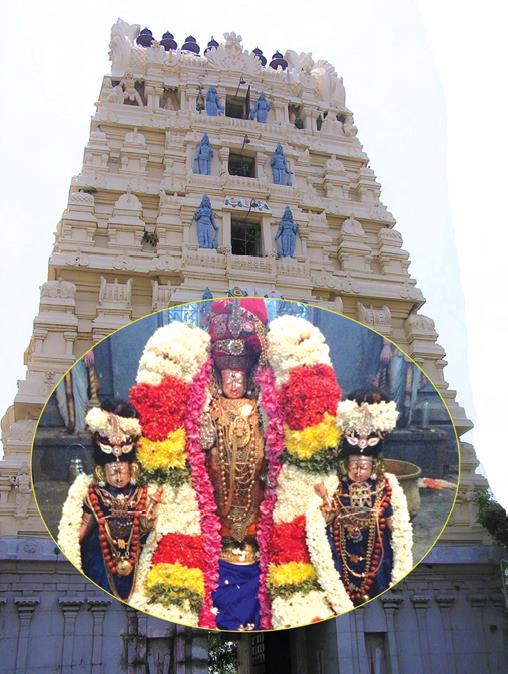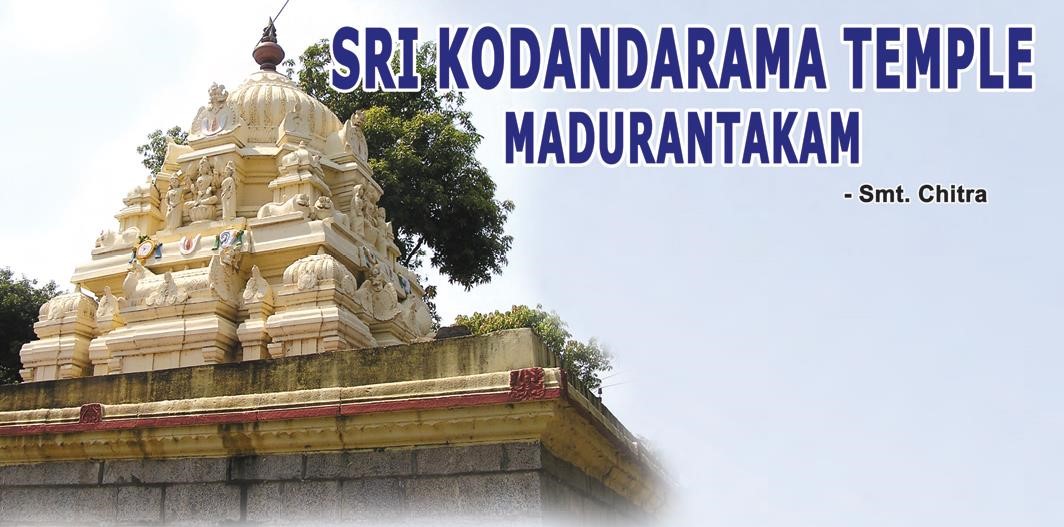Eri Katha Ramar Temple
One of the most important and famous Sri Rama temples in Tamil Nadu is in Maduranthakam, a small town in Chengalpattu district, of Tamil Nadu. Officially known as Sri Kodandarama temple, it is popularly called Eri Katha Ramar temple. This ancient place was originally known as Madurantaka Chaturvedimangalam as the Chola emperor Madurantaka Uttama Chola (973-985 A.D.), the son of Gandaraditya Chola donated this village to scholars of the four Vedas (Chaturvedins) who lived here.
The principal deities (moola-vigrahas) enshrined in the main sanctum of this east-facing temple are Sri Kodandarama (Eri Katha Ramar), Lakshmana, and Sita. These huge deities are made of stucco (sudhai in Tamil). In Tamil Nadu, there are many temples wherein the main deities are made of stucco such as the famous Lord Ranganatha Swami temple in Srirangam and also Lord Vishnu enshrined in the Yathoktakari, Pandava Doota and Ulagalanda Perumal temples in Kanchipuram.
In the temple at Maduranthakam, Rama and Lakshmana are seen holding their respective bows in their left hands and Sita stands to Rama’s right. The processional deity (utsava-bhera) of Lord Rama in this temple is also worshipped as ‘Eri Katha Ramar’. Here we can see, Karunakara Perumal (Lord Vishnu), flanked by Goddesses Sridevi and Bhudevi, believed to have been worshipped by God Rama.
All the deities in the main sanctum, including Sri Sudarsana are enshrined under the Pushpaka Vimana. An inner enclosure (prakaram) with a raised pillared veranda runs around the main sanctum.

In this temple, Lord Rama and Lakshmana are seen holding their respective bows in their
left hands and Sita Devi stands to Rama’s right. Here Swami is called ‘Eri Katha Ramar’.
An interesting story
In the outer open prakaram, are situated many sub-shrines of which the most important one is for Maa Sita, worshipped here as Janakavalli. This sanctum, which faces east and has an inner prakaram and a pillared mandapa in front, was constructed in 1798. An interesting detail about this sanctum is that it was constructed on the orders of Colonel Lionel Place, who was then the Collector of Chengalpattu.
The story of how an English official came to be associated with this temple is truly fascinating. In Maduranthakam, close to this temple is a large irrigation tank. Whenever it rained heavily, the breaches in this tank led to the flood waters damaging the crops in the village. During 1795-1798, the Collector of Chengalpattu decided to rectify the situation and in 1798, he stayed in Madurantakam during the rainy months with his engineers.
He came to see the temple and saw lots of stones inside. On enquiring why they were there, the people there said that they were constructing a separate sanctum for Sita but unfortunately were unable to complete it as the crops had been damaged due to floods and they could not donate to this noble cause. The Collector then said that if God Rama would prevent the breaches in the irrigation tank, he would construct the shrine for Sita.
In the following days, there was heavy rainfall in the area. The Collector, wanting to see if the arrangements for preventing the breaches were intact, walked near the bund of the irrigation tank when he saw two Divine Beings with bows and arrows guarding the bund. At once, he knelt and prayed to Rama and later said that he had a vision of Rama and Lakshmana. The tank did not breach that year and the crops were saved. Colonel Place immediately kept his promise and made the necessary arrangements for building the shrine for Goddess Sita (Janakavalli).
There is a Tamil epigraph that mentions that Colonel Lionel Place built this shrine. There is a sanctum for Andal Devi and opposite it is one for Sri Vishvaksena. Near the entrance to the temple is a sanctum enshrining a stone image of Sudarsana (personification of the discus of Lord Vishnu) in His pose of moving forward with God Narasimha on the reverse side. Situated nearby are shrines for the Alwars and Sri Vedanta Desika.
There is also a sanctum for Sri Lakshmi Narasimha with a circumambulatory path (pradakshina patha) in this temple. At the entrance to the temple is a tall five storeyed gopuram. The sacred tank (pushkarini) of this temple is called Sri Rama Tirtham and Sri Ramanuja Tatakam. On the banks of this tank is a shrine for Anjaneya Swamy, facing the main temple.
Ramanujacharya’s connection with Madhurantakam
There are many Vishnu temples in Tamil Nadu which are connected to the life of Ramanujacharya. This temple in Maduranthakam is one such and is connected with an important milestone event in his life. Yamunacharya (Alavandar), a famous Srivaishnava Acharya, wanted Ramanuja to come to Srirangam to spread and establish the Srivaishnava tradition (sampradaya).
Periya Nambi (also known as Maha Purna), Yamunacharya’s disciple started from Srirangam to go to Kanchipuram to meet Ramanuja. Ramanuja was also anxious to meet Periya Nambi and decided to go to Srirangam. The important and historic meeting between Ramanuja and Periya Nambi took place at Maduranthakam.
There is a small four-pillared mandapa to the rear of the Andal shrine is the place under the Magizha tree where Sri Ramanuja was given Pancha Samskara (Samashrayanam) by his teacher (Acharya), Periya Nambi. Shrines for Udaiyavar (Ramanuja) and Periya Nambi are seen near the Vishvaksena shrine.
Festivals
The most important festival in this temple is the Rama Navami Utsavam.

